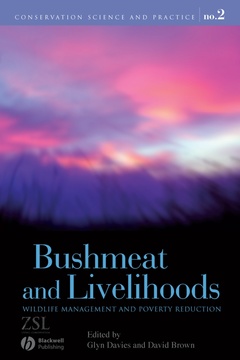Bushmeat and Livelihoods Wildlife Management and Poverty Reduction Conservation Science and Practice Series
Coordonnateurs : Davies Glyn, Brown David

- Assembles biological, social and economic perspectives that illuminate the bushmeat debate
- Features a series of case studies that explore what species survive different intensities of bushmeat hunting and trapping
- Examines the shape and size of household bushmeat consumption and market trading
- Reviews governance and institutional impacts on wildlife management; lessons learned from agriculture, forest plant product, and development sectors; and perspectives from Asia and Latin America
- Provides an excellent resource for students and policy makers in wildlife management, conservation, and development
Preface.
Introduction (David Brown and Glyn Davies).
Part 1. Bushmeat: Markets and Households (Glyn Davies and John G. Robinson).
1. Hunting and trapping in Gola forests, south-eastern Sierra Leone: Bushmeat from farm, fallow and forest (Glyn Davies, Björn Schulte-Herbrüggen, Noëlle F. Kümpel, and Samantha Mendelson).
2. Livelihoods and sustainability in a bushmeat commodity chain in Ghana (Guy Cowlishaw, Samantha Mendelson, and J. Marcus Rowcliffe).
3. Bushmeat markets – white elephants or red herrings? (John E. Fa).
4. Cameroon: from free gift to valued commodity. The bushmeat commodity chain around the Dja Reserve (Hilary Solly).
5. Determinants of bushmeat consumption and trade in continental Equatorial Guinea: an urban-rural comparison (Noëlle F. Kümpel, Tamsyn East, Nick Keylock, J. Marcus Rowcliffe, Guy Cowlinshaw, and E.J. Milner-Gulland).
6. Livelihoods, hunting and the game meat trade in northern Zambia (Taylor Brown and Stuart A. Marks).
Part 2: Institutional contexts (E.J. Milner-Gulland).
7. Is the best the enemy of the good? Institutional and livelihoods perspectives on bushmeat harvesting and trade – some issues and challenges (David Brown).
8. Bushmeat, wildlife management, and good governance: rights and institutional arrangements in Namibia’s community based natural resources management programme (Christopher Vaughan and Andrew Long).
9. Wildlife management in a logging concession in Northern Congo: can livelihoods be maintained through sustainable hunting? (John R. Poulsen, Connie J. Clark, and Germain A. Mavah).
10. Institutional challenges to sustainable bushmeat management in Central Africa (Andrew Hurst).
Part 3. Extra-Sectoral Influences and Models (Jo Elliott).
11. Can wildlife and agriculture coexist outside protected areas in Africa? A hopeful model and a case study in Zambia (Dale M. Lewis).
12. Food for thought for the bushmeat trade: lessons from the commercialisation of plant NTFPs (Elaine Marshall, Kathrin Schreckenberg, Adrian Newton, Dirk Willem te Velde, Jonathan Rushton, Fabrice Edouard, Catarina Illsley, and Eric Arancibia).
13. Bushmeat, forestry and livelihoods: exploring the coverage in PRSPs (Neil M. Bird and Chris S. Dickson).
14. The Beverly and Qamanirjuaq Caribou Management Board (BQCMB): blending knowledge, people and practice for barren-ground caribou conservation in Northern Canada (Ross C. Thompson).
Part 4: Regional perspectives (Glyn Davies and Ruth Whitten).
15. Hunting, wildlife trade and wildlife consumption patterns in Asia (Elizabeth L. Bennett).
References.
Index.
David Brown is a Research Fellow of the Overseas Development Institute in London. A sociologist, he has over 30 years’ experience in the tropics, mainly in West-Central Africa and has published extensively on development policy issues, particularly in the forest sector.
Date de parution : 11-2007
Ouvrage de 288 p.
16x23.6 cm



